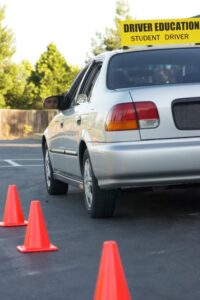“Dad, can you take me to the mall?”
“Mom?”
“Anyone?”
Every driver looks back on these days with a shudder, and remembers canvassing the house for a ride to the movies, a party or just to a friend’s house. Getting your driver’s license means never having to depend on chauffeur service from family members or friends ever again.
It also means you could be the one driving people around every now and then, but hey, as long as you’ve got the wheel.
That’s not to say passing your driver’s test will be a cakewalk. Finally getting your license will require focus and preparation, not to mention following every rule of the road to a T — even if not everyone else is.
The good news is that once you pass, you’ll never have to take it again – and that ride home from the DMV may just be the sweetest taste of freedom you’ll ever have.
Here are some simple, effective tips to help you ace that first driver’s test and leave asking for a lift in the dust.
1. Take the Sign
There are a lot of traffic signs on the road, and all of them mean something – so learn them! Your driving examiner will be paying close attention to how you respond to traffic indicators. If you come to a stop sign, come to a full stop, look both ways, wait a couple seconds and then go when the coast is clear. If it’s a school zone sign, make sure to slow down to below its posted speed limit. Flashing red light? Come to a full stop, look both ways, then continue.
Read up on common traffic signs you may encounter on the road, and test yourself on your knowledge before you head to the DMV. Try to understand the rules instead of just memorizing them for the test. The more you understand, the more natural they’ll be to follow.
2. No Need for Speed
While you should already be mindful of checking for speed limit signs, keep the velocity to a lower level even if there are no signs around and people are whizzing by. They are likely speeding, but they already have their licenses!
Remember that residential roads typically have speed limits of around 25 miles per hour, and highways typically have limits of 55 miles per hour and upward. Stay below these in the appropriate places and you should be fine.
3. Give Them Space
Keep at least three to four car lengths between you and the car in front of you. As a new driver, you may not have the experience to react quickly and correctly if someone comes to a sudden stop. The distractions of the road, constantly checking for traffic signs and even thoughts can cause you to be a split-second late at the worst time – and nothing will cut a driver’s test short faster than an accident.
4. Ease the Brakes
Your examiner will be watching to see how you decelerate the car and come to a stop – and they won’t appreciate the whiplash of going from 40 to zero in just a few seconds. If you see a stop sign or a traffic light in the distance, start braking early and coast to a smooth stop. Not only will it impress the examiner, it will help prevent accidents from cars behind you not being prepared for a sudden, jolting stop.
Car Accident Lawyer in Connecticut

5. Stay Behind the Line
A common mistake some drivers make is going over the line at an intersection. These lines mark crosswalks that are designed for pedestrians to get across the street, and crossing into them is a violation of both the law and their personal space. Slow down and inch up to the line if you need to, stopping about a foot away.
6. Save the Casual Grip
You probably have a comfortable way of gripping the steering wheel if you’ve been practicing. It might even be with one hand at times. That won’t fly in a driver’s license test, where the name of the game is rules, rules, rules. Your hands should be at the 10 and 2 (as if hands on a clock) position, allowing the examiner to see you’re taking the test seriously and helping you to make gradual, smooth turns.
7. Right Lane, Right Idea
The left lane is for passing. Stay out of it unless you need to turn left at a street or intersection. Being in the left lane can also encourage speeding, or it may cause cars behind you to tailgate if you are under the speed limit – which you should be.
8. Signal Early and Often
Turn signals let other drivers, and pedestrians, know when you are about to make a turn. Even if there is no one around, it’s still important to let your examiner see that you are diligent about following the rules of the road. Use your signal whenever you about to make a turn, and switch it on In advance of the turn to give any other motorists or pedestrians fair warning.
9. Relax
Nerves before a driver’s test can be shaky, but remember – it’s just driving! As long as you know what to look for, how to respond to signs and follow the rules of the road, you’ll be fine.
Practice as much as possible until changing lanes, flipping the signal and stopping at the right times becomes natural. It will help in conditioning you to drive the right way, and it will also help relieve anxiety about the test.
It may all seem like a blur right now, but soon you’ll look back on your driver’s test and wonder what the big deal was. Then, you’ll take yourself out for pizza.
